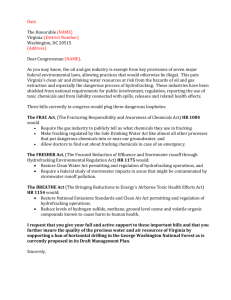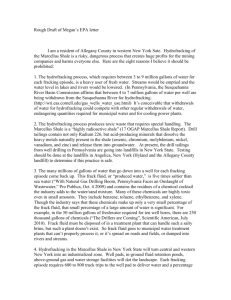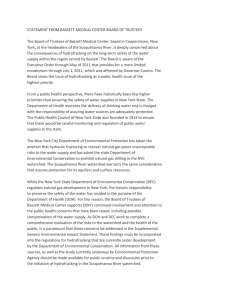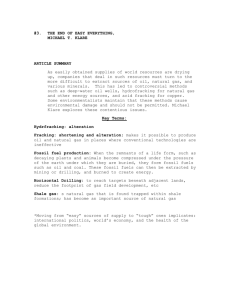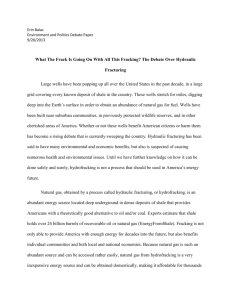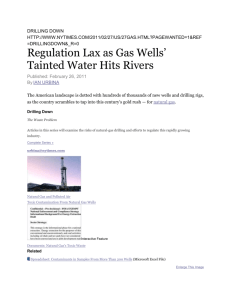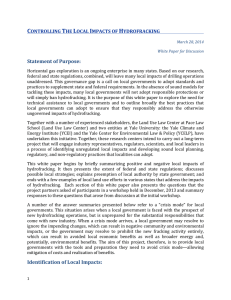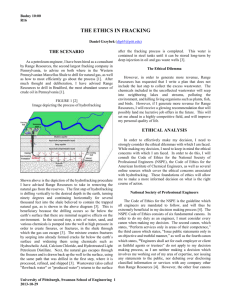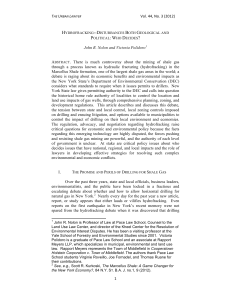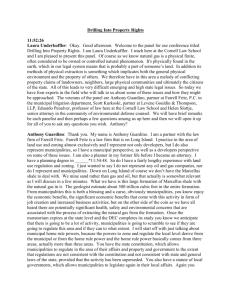Resolution on Hydrofracking Adopted by 2012 JCPA Plenum The
advertisement
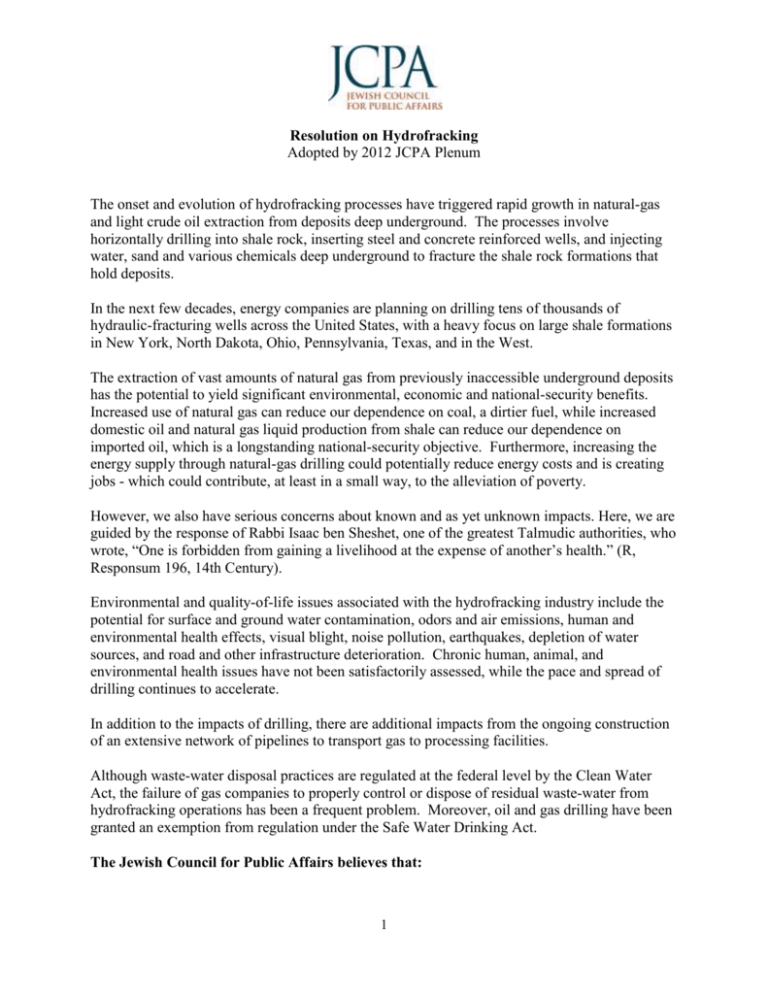
Resolution on Hydrofracking Adopted by 2012 JCPA Plenum The onset and evolution of hydrofracking processes have triggered rapid growth in natural-gas and light crude oil extraction from deposits deep underground. The processes involve horizontally drilling into shale rock, inserting steel and concrete reinforced wells, and injecting water, sand and various chemicals deep underground to fracture the shale rock formations that hold deposits. In the next few decades, energy companies are planning on drilling tens of thousands of hydraulic-fracturing wells across the United States, with a heavy focus on large shale formations in New York, North Dakota, Ohio, Pennsylvania, Texas, and in the West. The extraction of vast amounts of natural gas from previously inaccessible underground deposits has the potential to yield significant environmental, economic and national-security benefits. Increased use of natural gas can reduce our dependence on coal, a dirtier fuel, while increased domestic oil and natural gas liquid production from shale can reduce our dependence on imported oil, which is a longstanding national-security objective. Furthermore, increasing the energy supply through natural-gas drilling could potentially reduce energy costs and is creating jobs - which could contribute, at least in a small way, to the alleviation of poverty. However, we also have serious concerns about known and as yet unknown impacts. Here, we are guided by the response of Rabbi Isaac ben Sheshet, one of the greatest Talmudic authorities, who wrote, “One is forbidden from gaining a livelihood at the expense of another’s health.” (R, Responsum 196, 14th Century). Environmental and quality-of-life issues associated with the hydrofracking industry include the potential for surface and ground water contamination, odors and air emissions, human and environmental health effects, visual blight, noise pollution, earthquakes, depletion of water sources, and road and other infrastructure deterioration. Chronic human, animal, and environmental health issues have not been satisfactorily assessed, while the pace and spread of drilling continues to accelerate. In addition to the impacts of drilling, there are additional impacts from the ongoing construction of an extensive network of pipelines to transport gas to processing facilities. Although waste-water disposal practices are regulated at the federal level by the Clean Water Act, the failure of gas companies to properly control or dispose of residual waste-water from hydrofracking operations has been a frequent problem. Moreover, oil and gas drilling have been granted an exemption from regulation under the Safe Water Drinking Act. The Jewish Council for Public Affairs believes that: 1 Studies into hydrofracking impacts, including impacts on groundwater sources, surface water sources, air quality, human and animal health, infrastructure and ecosystems, should be continued and conducted with urgency by federal and state regulatory agencies. Appropriate safeguards to protect public health and the environment should be adopted and enforced based on the identification of impacts. Impact fees and/or severance taxes should be sufficiently high to not only cover all of the costs governments incur in regulating and accommodating extraction, but also to fund environmental conservation and restoration programs and to fund research into the impacts of large-scale natural-gas extraction. Federal, state and local governments should seek an appropriate and coordinated distribution of authority given their respective areas of responsibility, in a fashion that is focused on both the benefits of development of these natural resources as in the national interest and on the need to minimize negative environmental impact. States should ensure that permitting processes require the collection and analysis of all appropriate site data, including both baseline data on environmental conditions and ongoing monitoring. States should require safeguards for protecting underground water sources and adequate setbacks to keep drilling sites a safe distance away from residences, schools, healthcare facilities, creeks, lakes, rivers, and sources of public-drinking-water supplies, as well from other areas of high ecological value. Bonding requirements should be sufficiently high to cover future costs of well plugging, abandonment, and site restoration. State and federal regulatory authorities need an adequate legal framework, sufficient numbers of adequately trained personnel and adequate funding to ensure appropriate regulatory oversight. The adverse environmental and health impacts of hydrofracking should be evaluated in the context of similar impacts associated with other sources of energy. The drilling industry must identify all chemicals used in the fracking process, stop using any that are banned by appropriate regulation, and should be strongly urged to find and use nonhazardous substitutes for hazardous chemicals used in the fracking process. Drillers should be encouraged to recycle and/or ensure proper disposal of all wastewater. An increase in the natural-gas supply should not result in reduced investment in research and development of alternative and renewable energy sources. The community relations field should: Support adequate federal and state regulation to protect groundwater sources, surface water sources, air quality, human and animal health, infrastructure and ecosystems. Support federal legislation to eliminate the natural-gas industry’s exemption from the Safe Drinking Water Act. Support legislation and regulation enabling the EPA to require full disclosure of the type and amount of hydrofracking chemicals used at each well site. Educate their communities about the extraction of natural gas and oil by hydrofracking and about relevant Jewish perspectives on the issue. Support preservation of unique and/or sensitive areas by putting them off limits to gas drilling to be determined by an appropriate science-based process. 2
